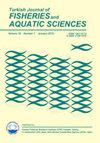Red Mullet (Mullus barbatus ponticus Essipov, 1927) Stock Exploitation in Georgian Coastal Waters (2019-2021)
IF 1.7
4区 农林科学
Q3 FISHERIES
引用次数: 0
Abstract
The aim of this study is to assess the level of the red mullet stock exploitation in Georgian coastal waters using the CMSY, LBB and LB-SPR modeling methods. The samplings were carried out using bottom trawls in 2019-2021. In total 4957 individuals were sampling (1 508 cases age was determined using scales and otoliths). Average annual catch of the red mullet make up 11.7±3.3 t (0.3% of the total annual Black Sea countries landings). The total length ranged from 6.1 to 20.7 cm. 70% of landings consisted of 3+, 4+ and 5+ age. The length-weight relationship was calculated as W=0.0072 × L3.20. Average von Bertalanffy growth parameters were L∞=18.00±0.27 cm, k=0.31±0.03, and t0= –0.93±0.26. LBB method demonstrate that the red mullet stock was overexploited (F/M=2.7 more than optimal level F/M=1.0). According to CMSY analysis, biomass has been decreasing to Blim for the researched period. The LB-SPR result showed that the estimated SPR was 23%. The exploitation of the stock was steadily intensive according to CMSY and LB-SPR methods. Increase in fishing mortality is not recommended.格鲁吉亚沿海水域红鲻鱼(Mullus barbatus ponticus Essipov, 1927)种群开发(2019-2021)
本研究的目的是利用CMSY、LBB和LB-SPR模型方法评估格鲁吉亚沿海水域红鲻鱼种群的开发水平。这些取样是在2019-2021年使用底拖网进行的。共抽取4957例样本(1508例使用耳石和鳞片测定年龄)。红鲻鱼年平均捕获量为11.7±3.3吨(占黑海国家年总捕获量的0.3%)。总长度为6.1 ~ 20.7 cm。70%的着陆点为3+、4+和5+年龄段。长度-权重关系计算为W=0.0072 × L3.20。平均von Bertalanffy生长参数L∞=18.00±0.27 cm, k=0.31±0.03,t0= -0.93±0.26。LBB法表明,红鲻鱼种群处于过度开发状态(F/M=2.7,比最优水平F/M=1.0高出2.7)。根据CMSY分析,在研究期间,生物量呈下降趋势,降至3亿立方米。LB-SPR结果表明,估计SPR为23%。根据CMSY和LB-SPR方法,对该种群进行了稳定集约化开发。不建议增加捕鱼死亡率。
本文章由计算机程序翻译,如有差异,请以英文原文为准。
求助全文
约1分钟内获得全文
求助全文
来源期刊

Turkish Journal of Fisheries and Aquatic Sciences
FISHERIES-MARINE & FRESHWATER BIOLOGY
CiteScore
3.10
自引率
0.00%
发文量
43
审稿时长
3 months
期刊介绍:
Turkish Journal of Fisheries and Aquatic Sciences" (TrJFAS) is a refereed academic journal has been published by Central Fisheries Research Institute of Turkey and Japan International Cooperation Agency (JICA), and published in English.
It aims to address research and needs of all working and studying within the many varied areas of fisheries and aquatic sciences.
The Journal publishes English language original research papers, critical review articles, short communications and technical notes on applied or scientific research relevant to freshwater, brackish and marine environments.
TrJFAS was published biannually (April & November) between 2001 and 2009. A great number of manuscripts have been submitted to the journal for review from acceptance of the SCI index. Thereby, the journal has been published quarterly (March, June, September and December) from 2010 to 2017. The journal will be published monthly in 2018.
 求助内容:
求助内容: 应助结果提醒方式:
应助结果提醒方式:


